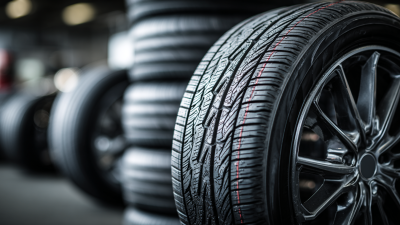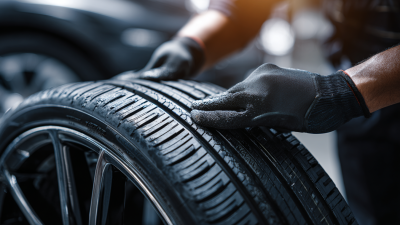2025 Top Wheel Balancing and Alignment Solutions for Perfect Tire Performance
In 2025, achieving optimal tire performance is paramount for both safety and efficiency on the road. Central to this goal are advanced wheel balancing and alignment techniques that ensure vehicles operate smoothly and efficiently. As technology continues to evolve, so too do the solutions available to drivers and fleet operators seeking to enhance their tire life and improve overall vehicle handling. This comprehensive overview will explore the top wheel balancing and alignment solutions of the year, highlighting innovative products and methodologies that contribute to superior tire performance.
The importance of precise wheel balancing and alignment cannot be overstated. Misalignment or imbalances can lead to uneven tire wear, reduced fuel efficiency, and compromised driving safety. With the latest advancements in technology, businesses and consumers alike are now presented with a myriad of options designed to address these critical aspects. From high-tech diagnostic equipment to user-friendly balancing machinery, the market is rich with solutions that promise to extend tire longevity while ensuring a smooth ride. As we delve into the top offerings for 2025, readers will gain insight into how these tools can transform both personal and commercial driving experiences.

Innovative Wheel Balancing Technologies Revolutionizing Tire Performance
As the automotive industry progresses, the importance of innovative wheel balancing technologies cannot be overstated. These advancements are revolutionizing tire performance, significantly enhancing safety and efficiency on the road. Modern solutions, such as dynamic balancing and computerized alignment systems, allow for precise adjustments that minimize vibrations and improve the lifespan of tires. Such technologies not only optimize driving comfort but also contribute to better fuel efficiency, making them a worthy investment for vehicle owners.
Tips for Effective Tire Performance:
- Regularly inspect your tires for signs of uneven wear, which may indicate the need for balancing and alignment.
- Schedule professional balancing and alignment services at least once a year or whenever you replace tires to ensure optimal performance.
- Consider using tire pressure monitoring systems (TPMS) to detect any fluctuations in tire pressure that can impact your vehicle's handling and safety.
The shift towards advanced wheel balancing equipment reflects a growing recognition of its critical role in maximizing tire performance. With features such as automated adjustments and real-time data analysis, these solutions not only streamline the alignment process but also empower drivers to achieve the best possible outcomes for their vehicles. Investing in these innovative technologies is a crucial step towards ensuring a smoother, safer driving experience.

Advanced Alignment Solutions for Enhanced Vehicle Handling
In the realm of automotive technology, advanced alignment solutions are crucial for enhancing vehicle handling and ensuring optimal tire performance. These innovations are designed to improve the precision of wheel alignment, which directly affects the vehicle's stability, steering response, and overall safety on the road. Modern alignment systems utilize advanced sensors and software to recalibrate the angles of the wheels, ensuring that they are aligned not just for operational efficiency but also for a smoother driving experience.
As the automotive sector evolves, the demand for such technology is surging. By 2025, the global automotive audio market is projected to reach an impressive size, reflecting the industry's growth and the increasing importance of high-performance components. This trend underscores the critical role that alignment solutions play in maximizing tire longevity and enhancing consumer satisfaction. With a compound annual growth rate of 7.2% anticipated until 2032, it is clear that investing in advanced alignment technologies will not only boost vehicle performance but also contribute significantly to the profitability of automotive service providers.
Eco-Friendly Wheel Balancing Options: Sustainability Meets Performance
As the automotive industry faces an increasing demand for eco-conscious practices, wheel balancing and alignment solutions are evolving to incorporate sustainable materials and methods. Traditional wheel balancing often relies on lead weights, which pose environmental risks. In response, innovative companies are now offering biodegradable and recycled materials that not only ensure optimal performance but also minimize ecological impact. These eco-friendly options maintain tire performance while contributing to a greener planet.
In addition to material innovations, some wheel alignment services are adopting technologies that reduce energy consumption and waste. For instance, advanced laser alignment systems enhance precision and reduce the need for rework, thus conserving resources. By integrating sustainability into wheel balancing and alignment processes, automotive businesses can meet the dual demands of performance and environmental responsibility. This trend not only appeals to eco-conscious consumers but also sets a new standard for the industry, paving the way for a more sustainable future in tire performance.

Expert Recommendations for Professional Tire Maintenance Services
Ensuring optimal tire performance goes beyond just purchasing the right tires; it involves
professional tire maintenance services, particularly in
wheel balancing and alignment. Expert recommendations emphasize that regular maintenance not only prolongs the lifespan of tires but also enhances vehicle safety and fuel efficiency.
Professionals utilize advanced diagnostic tools to identify misalignments, which can lead to uneven tire wear and compromised performance. Investing in reliable tire services can prevent the long-term costs associated with premature tire replacement.
Furthermore, choosing the right service provider is crucial. Look for establishments that offer comprehensive inspections and have a solid reputation in the industry. Experienced technicians should be able to assess your vehicle's specific needs, taking into consideration factors such as driving habits and local road conditions.
They should recommend tailored solutions, whether it's a simple balance adjustment or a more involved alignment service, to ensure that your tires perform at their best. Maintaining this professional service routine will not only keep your tires in top condition but will also contribute significantly to your overall driving experience.
Future Trends in Wheel Balancing and Alignment Technologies
As the automotive industry continues to evolve, the future of wheel balancing and alignment technologies is poised for remarkable innovation. One prominent trend is the integration of smart sensors and real-time data analytics, enabling technicians to monitor wheel performance live. These advanced systems will facilitate proactive maintenance, allowing for instant adjustments based on driving conditions and tire wear. The use of Artificial Intelligence (AI) in these processes will not only optimize the balancing and alignment procedures but also predict potential issues before they escalate.
Another significant trend is the development of mobile and automated solutions designed to enhance efficiency and convenience. Mobile calibration units equipped with cutting-edge technology will allow service providers to conduct wheel balancing and alignment on-site, minimizing vehicle downtime. Furthermore, advancements in robotics and automation will pave the way for precision alignment systems that reduce human error and deliver consistent results. As consumers increasingly demand flawless tire performance, the automotive sector will adapt by adopting these innovative technologies, ensuring a smooth and efficient driving experience in the years ahead.
Related Posts
-

Exploring the Impact of Tire Technology on Auto Performance and Safety in 2023
-

How to Choose the Best Tire Repair Shop for Your Vehicle Needs
-

Unlock Amazing Savings: The Ultimate Guide to Car Tyres Offers You Can't Miss!
-

Discover the Best Local Tire Shops for Your Vehicle Needs Near You
-

The Real Factors Influencing Tire Alignment Cost: What Every Car Owner Should Know
-

The Ultimate Guide to Car Tyre Repair Techniques and Their Impact on Road Safety